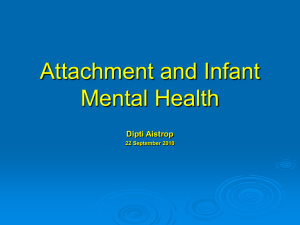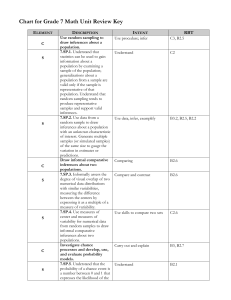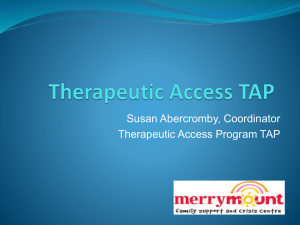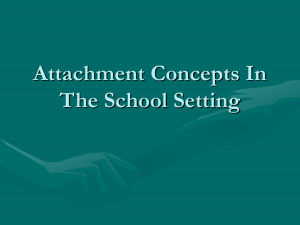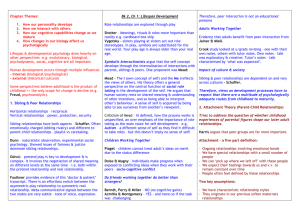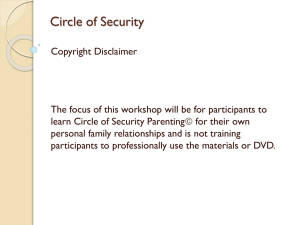WWB #24 Training Kit Attachment: What Works?
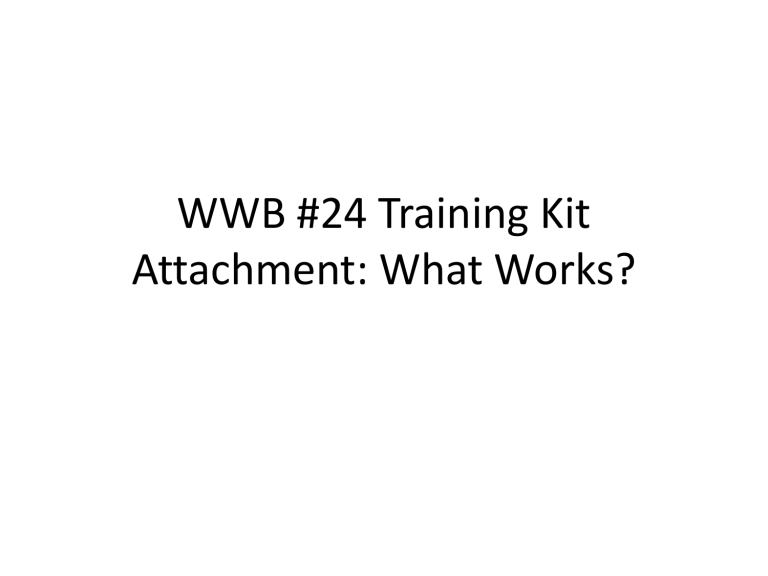
WWB #24 Training Kit
Attachment: What Works?
Attachment
• What is attachment?
• Why is it important for young children and caregivers?
What Is Attachment?
• The continuing and lasting relationships that young children form with one or more adults.
• Attachment refers especially to one aspect of the adult-child relationship: the child’s sense of security and safety when in the company of a particular adult.
• Importantly, individual children, and children from different cultures and family backgrounds may show secure and insecure attachment differently.
Why Is Attachment Important?
• Within secure relationships, children learn how to manage their strong emotions and reactions and develop their identities.
• Infants and toddlers thrive when most or all of their relationships with adults in their lives are secure.
•
•
•
•
•
•
Activity
Pair-Think-Share
Make a list of child behaviors associated with secure and insecure attachment
Secure Attachment Relationships Insecure Attachment Relationships
•
•
•
•
•
•
Characteristics of Children with
Insecure Attachment Relationships
• Behave as if they know that adults are inconsistently or seldom available.
• Stay close to an adult to get their needs met, inhibiting their exploration of their environment.
• Do not seek adult help to deal with emotions when distressed.
• Hide strong feelings; withdraw to avoid distressing events or to organize their emotions.
• Seem disorganized and confused about how to behave in relationships.
Characteristics of Children with Secure
Attachment Relationships
• Trust that their physical needs will be met by adults.
• Trust that adults will be emotionally available.
• Learn to communicate in a variety of ways.
• Begin to manage (self-regulate) their strong reactions and emotions with adult help.
Fostering the Parent-Child Relationship
• Help parents feel competent and confident in their parenting (e.g., notice and describe when parents are warm, responsive, and nurturing with their child; help parents recognize their strengths as parents).
• Provide extra support to parents when needed, such as when child illness, behavior, disability, or temperament may be challenging.
Fostering Secure Relationships with the Child
• Be warm, responsive, and affectionate with all children; read and respond to children’s cues (e.g., smiling, reaching to indicate they want interact, pulling away to indicate a break in interaction is needed, showing sadness).
• Engage in meaningful conversational interactions with children; take turns speaking.
• Be physically and emotionally available as children explore their environments; provide hugs, encouragement.
• Consistently comfort children when they are distressed.
Fostering Secure Relationships with the Child
• Be an enthusiastic learning partner (e.g., help child with problem solving, follow child’s lead).
• Let children know that you will provide them with a safe environment and demonstrate safe behavior (e.g., show a child how to gently touch a peer).
• Provide consistency in personnel, time and space for
1:1 adult-child relationships; allow caregivers and teachers to move with a group of children to a new room as they develop.
• Develop program policies to refer families to appropriate mental health support as needed.
Activity
What Would You Do?
• Marla, a 9-month-old, was startled when a parent entered the room.
• After falling off of a low bench, Devon, an 18month-old, ran across the playground appearing to not know what to do.
Pre-Training Survey
• What is attachment?
• Why is it important to children’s development?
• What are two characteristics of secure and insecure child attachment?
• What strategies can caregivers use to foster secure attachment relationships with children?



